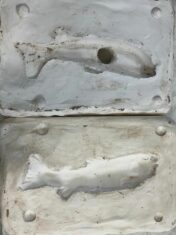I am deeply grateful to the Parents Association for sponsoring my participation in a class at Greenwich House Pottery. The six-week course, Mixed Level Mold Making and Slipcasting, covered techniques for creating multi-part plaster molds used in ceramic slip casting. Slipcasting enables ceramicists to replicate forms by pouring liquid clay, or slip, into plaster molds. Although I primarily work as a sculptural ceramicist who builds forms by hand, this class gave me a valuable tool to combine my hand-building techniques with the ability to quickly reproduce my creations. This skill is highly valuable to MMFS students as it allows them greater freedom to experiment with glazing techniques with a series of identical forms.
This experience has already proven invaluable in my Ceramics II class, where we began the year by designing and constructing one-part press tile molds. Students identified undercuts in their forms, prepared cottle boards with clay, and learned how to mix, pour, and cure plaster. They also practiced cleaning their molds before pressing. This project allowed them to create a set of six identical tiles, which they used as test tiles to experiment with various glaze combinations and to finalize designs with underglaze.
This course not only expanded my curriculum knowledge but also connected me with the supportive community at Greenwich House Pottery Studio. Through this connection, I’ve arranged a field trip for Ceramics II students to visit their gallery and meet with the current resident artist, Kristy Moreno. I look forward to this continued connection with Greenwich House as an educational outlet for our students. I am incredibly grateful to the Parents Association for their generous support, which has enriched both my teaching and artistic practice through this unique learning experience.
The Techniques:
 We began by learning how to assess the form we intended to replicate, focusing on finding the midpoints (parting lines) and determining where the mold’s divisions would go. This step was crucial because accurately identifying the middle point allowed us to split the form into parts that could be released from the mold without damaging the original piece. We then moved on to recognizing undercuts, which are areas on the form that could potentially catch or prevent the mold from separating smoothly. Understanding these factors helped us design molds and alter our forms so they could be replicated without damage. I first selected a handbuilt ceramic fish I created months before to cast. As a relatively simple form free of undercuts, this form would be used to create a two-part mold. I identified the form’s parting line and marked it in Sharpie. Next, I prepared a thick slab of clay and submerged half of the form below the clay. Wooden cottle boards were then arranged around the form to prevent spillage once the liquid plaster was poured on top of the form.
We began by learning how to assess the form we intended to replicate, focusing on finding the midpoints (parting lines) and determining where the mold’s divisions would go. This step was crucial because accurately identifying the middle point allowed us to split the form into parts that could be released from the mold without damaging the original piece. We then moved on to recognizing undercuts, which are areas on the form that could potentially catch or prevent the mold from separating smoothly. Understanding these factors helped us design molds and alter our forms so they could be replicated without damage. I first selected a handbuilt ceramic fish I created months before to cast. As a relatively simple form free of undercuts, this form would be used to create a two-part mold. I identified the form’s parting line and marked it in Sharpie. Next, I prepared a thick slab of clay and submerged half of the form below the clay. Wooden cottle boards were then arranged around the form to prevent spillage once the liquid plaster was poured on top of the form.
Once the form was prepped, we learned to add essential features like the pour spout, which allows slip to flow into the mold. The pour spout placement was critical for ensuring the entire form would be filled without trapping air bubbles. After these structural considerations, we mixed and poured plaster, following precise ratios to achieve the right consistency and strength.
 When creating my second slip-cast mold, I chose to hand-build a new form, applying my newly acquired skills in identifying undercuts and marking points for an effective design. After pouring the two-part plaster mold and letting it cure, I noticed a small undercut that I had initially overlooked. My instructor showed me how to carefully carve out parts of the plaster to correct this, teaching me a valuable skill for adjusting molds.
When creating my second slip-cast mold, I chose to hand-build a new form, applying my newly acquired skills in identifying undercuts and marking points for an effective design. After pouring the two-part plaster mold and letting it cure, I noticed a small undercut that I had initially overlooked. My instructor showed me how to carefully carve out parts of the plaster to correct this, teaching me a valuable skill for adjusting molds.